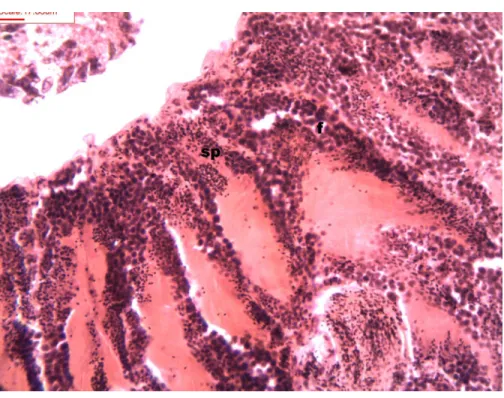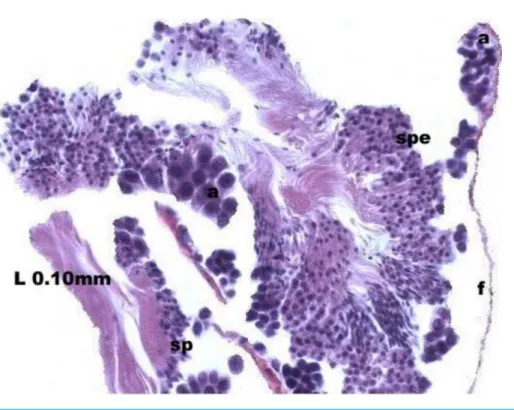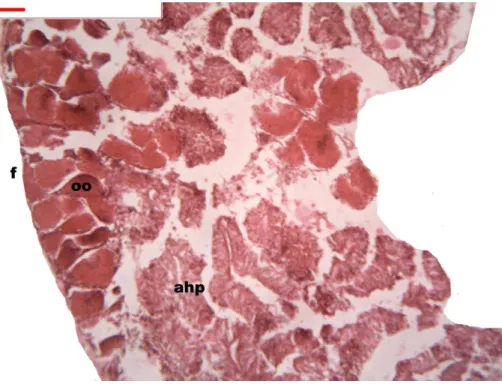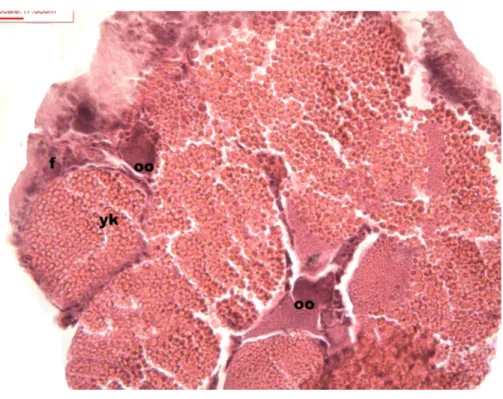Submitted17 April 2016 Accepted 12 September 2016 Published6 October 2016
Corresponding author Stella Maris Martin, smartin@fcnym.unlp.edu.ar
Academic editor Tim Collins
Additional Information and Declarations can be found on page 9
DOI10.7717/peerj.2548
Copyright 2016 Martin and Díaz
Distributed under
Creative Commons CC-BY 4.0
OPEN ACCESS
Histology and gametogenesis in
Heleobia
piscium
(Cochliopidae) from the Multiple
Use Reserve ‘‘Isla Martín García,’’ Buenos
Aires, Argentina
Stella Maris Martin1and Ana C. Díaz2
1División Zoología Invertebrados-FCNyM-UNLP-Investigador Independiente CIC, Universidad Nacional de
La Plata, Buenos Aires, Argentina
2División Zoología Invertebrados-FCNyM-UNLP-Becaria Doctoral CONICET, Universidad Nacional de La
Plata, Buenos Aires, Argentina
ABSTRACT
Heleobia piscium(d’Orbigny, 1835), a member of the Cochliopidae family found only in South America, is distributed from Entre Ríos, Delta del Paraná, and the littoral of the Río de la Plata down as far as to Punta Indio (Buenos Aires), the southernmost limit of the snail’s geographical distribution. To date, little information is available regarding the reproductive cycle of species within this family either in Argentina or throughout South America. The present work analyzed the histology of the reproductive system of the gonochoric speciesH. pisciumand determined the stages oogenesis and spermatogenesis under natural conditions. Specimens ofH. pisciumwere collected in the Multiple-Use Natural Reserve Isla Martín García, located in the Upper Río de la Plata estuary to the south of the mouth of the Uruguay River. The gametogenic cycle in both sexes was found to consist of the following stages: early maturation, maturation, and evacuation. The maturation period was found to extend from January to October and evacuation of the gametes to start in November and end in February (summer in the Southern Hemisphere). The results indicated theH. pisciumexhibit a reproductive cycle without a resting period.
SubjectsZoology, Histology
Keywords Gametogenesis, Histology,Heleobia, Isla Martín García, Argentina
INTRODUCTION
HeleobiaStimpson, 1865 is a genus within the family Cochliopidae Tryon, 1866 (Wilke et al., 2001;Szarowska, Falniowski & Steffek, 2011) comprising 101 species, of which 90 are found in South America (Hershler & Thompson, 1992;Pons da Silva & Veitenheimer-Mendes, 2004;Cazzaniga, 2011;Collado, 2015).Rumi et al. (2006)andRumi et al. (2008)reported 16Heleobiaspecies for Argentina, of which 10 are endemic.
reproduction, dispersal strategies, behavior, and genetics of its species. Accordingly, few studies have dealt with the reproductive cycle species from Argentina or from South Amer-ica, except for those conducted byCazzaniga (1982)onLittoridina parchappii(d’ Orbigny, 1835) in the drainage channels of the lower valley of the Colorado-River province of Buenos Aires, Argentina.Arconada & Ramos (2002)investigated the pseudohermaphroditism of
Spathogyna fezi (Altimira, 1960), a member of the Hydrobiidae family. The analysis of other freshwater gastropods has provided information on the gametogenesis of species belonging to the families Tateidae e.g., Potamopyrgus antipodorum(Gray, 1843), an invasive species from New Zealand that has colonized Australia, Europe, and the Americas (Tair-Abbaci & Garric, 2012), and Ampullariidae e.g.,Pomacea canaliculata(Lamarck, 1801), Pomacea scalaris(D’Orbigny, 1835), and Asolene platae(Maton, 1809), species from Argentina (Martin, 1986;Martin, 1987;Martin, 1992). In México,Carreón-Palau et al. (2003)studied the reproductive system ofPomacea padula catemacensis(Baker, 1922); in TaiwanWu et al. (2011)studied the reproduction of the invasive the South American apple snails,Pomacea canaliculata(Lamarck, 1822) andPomacea scalaris(d’Orbigny, 1835) (Ampullariidae).
The work reported here was aimed at contributing essential information on the reproduc-tive process and strategy of a species of the genusHeleobiathrough histological examination of the reproductive system of the gonochoric speciesH. piscium, along with a determination of the gonadal maturation stages, oogenesis, and spermatogenesis under natural conditions.
MATERIAL AND METHODS
The specimens were collected in the Multiple-Use Natural Reserve Isla Martín García (authorized by the Dirección de Áreas Naturales Protegidas-OPDS Provincial Authority for Sustainable Development, Buenos Aires-La Plata Argentina. Authorization granted by note under docket number 2578-1530/2005-0), and deposited in the Malacological Collection at the Museo de La Plata, Buenos Aires Province, Argentina (MLP-Ma). Monthly collections were made from August 2005 through June 2007 in the eastern part of the island Arena Beach (34◦11′09′′S, 58◦15′09′′W) (Isla Martín García in located in the upper Rio de
la Plata), to the south of the mouth of the Uruguay river. This coastal stretch is delimited by the Canal del Infierno, which is characterized by a remarkable exposure to strong winds from the southeast. This area constitutes an outcropping of the Brazilian massif of Precambrian crystalline basement rock upon which lie sediments of the Holocene and Pleistocene epochs of the Quaternary Period (Ravizza, 1984).
Samples ofH. pisciumwere taken by hand in the coastal drainage channels formed by tidal erosion. A total 1,306 specimens were collected. The ratio of male to female specimens was 1 to 1.
resulting slices stained with hematoxylin-eosin (Gabe, 1968). Preparations of gonadal tissue at different stages of gametic development were observed under a Leica DM LS microscope and photomicrographs taken with a Tucsen USB2.0 camera connected to a microscope at 25×and 40×magnifications. After following the development of the gametogenic cycle in
both sexes (from the gametogenic stages present in each individual) within an annual cycle throughout the two consecutive years of the study, the following stages were determined: early maturation, maturation, and evacuation.
RESULTS
Heleobia piscium is a dioecious oviparous species with internal fertilization. Male and female gonads form a spiral within the digestive gland and are composed of numerous follicles surrounded by connective tissue. The male gonad consists of a number of digitiform projections gathered in small groups. The tube that emerges from each of those groups is thevas deferensthat travels from the base of the gonad to the anterior portion of the snail. Once in the ventral region, thevas deferensruns toward the stomach but, before reaching the posterior part of the stomach, turns back again toward the posterior part, finally returning to the stomach through the same route. In the posterior part of the stomach the
vas deferensbecomes rolled up, with the last section constituting the seminal vesicle. The male gonad is located in a small portion in the pallial cavity that is both the prostate gland.
The female reproductive system consists of the ovary, composed of follicles, the oviduct, the seminal receptacle, and the albumen gland. Like the penis, the gonadic follicles are dorsally located in the ventral or dorsolateral region of the digestive or hepatopancreatic gland, extending from the posterior portion of the stomach to the posterior end of the body. These follicles cover a smaller portion than that of the penis with respect to size of the digestive structure. The albumen gland is whitish and is topographically located in the posterior region of the pallial cavity.
Histology
We conducted a histological study of the male and female gonads to ascertain the details the gonadogenesis development and the organization of the internal tissues. Therefore, to follow the evolution of the different stages of spermatogenesis and oogenesis, we mainly considered the characteristics and morphology of the sexual cells.
Males
During spermatogenesis, in the early maturation of the follicles large numbers of spermatogonia (3.64–4.55 µm) and spermatocytes (1.82–2.73 µm) are present. Upon
complete maturation, spermatozoids become abundant in the lumen of the follicles, while the spermatocytes and spermatids (4.55µm) are observed around the border of the acinar
wall (Figs. 1,2and3).
Figure 1 Stages of spermatogenesis.Maturation of the germinal sexual cells in the male acini. Spermato-zoid, sp; follicle, f; hepatopancreatic acini, ahp.
Figure 3 Stages of spermatogenesis.Maturation of the germinal sexual cells in the male acini. Spermato-zoid, sp; follicle, f; hepatopancreatic acini, ahp.
Figure 5 Stages of oogenesis.Yolk granules surrounded by oocytes. The nucleus was prominent during the stages of maturation. Oocyte, oo; follicle, f; hepatopancreatic acini, ahp.
Females
During oogenesis immature female gonadal follicles are present they measure less than 3 mm. Only developing oocytes were identified.
Follicles measuring less than 3 mm have only immature female gonads lacking vitellus granules along with developing oocytes. In female specimens that have reached a total length of 3–4 mm, the vitellogenic oocytes occupy these gonadic follicles. This stage, in fact, constitutes the indication that gonadal maturation has been completed (Figs. 5and
6). Once reaching complete maturation, the female gonads begin evacuating their sexual cells. This evacuation is revealed by a spreading out of vitellus granules and a thinning of the oocytes, those being attached to the now extremely thin follicular walls (Fig. 7). At this stage cells referred to as amoebocytes with well colored nuclei located at one end of a wide, granulated cytoplasm appear to phagocytize residual oocytes. The histological cuts observed in females revealed that female follicles are surrounded by connective tissue. The small number of oocytes in the follicles attached to these thin follicular walls constitutes the evidence that sexual-cell evacuation has occurred.
DISCUSSION
Figure 6 Stages of oogenesis.Stages of oogenesis. Detail of the nucleus and nucleolus was as prominent in the stages of maturation. Oocyte, oo; nucleo, n.
other Caenogastropoda, such as the freshwater species of the Ampullariidae family that do not show such cells surrounding oocytes during the maturation stage (Martin, 1986;
Martin, 1987;Martin, 1992).
The maturation stage for both males and females took place from January through Oc-tober. During March, April, and May (the Southern-Hemisphere autumn) male and female individuals measuring 3.0–4.5 mm were at the early maturation stage. Complete maturation was observed during August, September, and October in specimens measuring 5.0–5.5 mm.Tair-Abbaci & Garric (2012)in the histological study and gonadal development of
Potamopyrgus antipodorumshowed early gonadogenesis when they reached 2 mm size, in
H. pisciumobserved for about the same size.
The male gonad was found to be distributed in a centripetal form similar to that observed in other Caenogastropods of the Littoridinidae family (e.g., Echinolittorina peruviana
(Lamarck, 1822);Castillo & Brown, 2008). This characteristic gives a variegated appearance to the gonad–digestive-gland complex, a formation quite different from a clearly separated gonad and digestive gland, or from digestion in a topographically separate location in other species.Hershler & Ponder (1998)described the same form of gonadal structure in several species of Hydrobiidae and based their description on the genital characteristics of
Spurwinkia salsa(Pilsbry, 1905).Carreón-Palau et al. (2003)inPomacea patula catemacen-sis(Baker 1922) andWu et al. (2011) observed that the gonad ofPomacea canaliculata
andPomacea scalarisis in close contact with the digestive gland, which constitutes the visceral coil.
The evacuation of the gametes started in November and ended in February (the Southern-Hemisphere summer).Cazzaniga (1982)had observed inL. parchappii, among southern snail populations, that the maturation stage for both males and females took place from January to September (spring–summer) with the evacuation of the gametes starting in September and ending in January for each annual cycle of that species in Argentina.
Heleobia pisciumexhibits a reproductive cycle without any resting period, a characteristic shared with members of the generaPomacea(Perry, 1811) andAsolene(D’Orbigny, 1837) studied byMartin (1986);Martin (1987);Martin (1992).
This present analysis of the population ofH. pisciumconstitutes the first study on the gametogenic cycle of a species of Cochliopidae. Both the males and the females within the population displayed a synchronous gametogenic cycle. These results indicate that the
H. piscium populations exhibit a continuous reproductive cycle in the absence of any resting period.
The present work, conducted at the Multiple-Use Natural Reserve Isla Martín García (Argentina), provides essential information on the annual reproductive cycle ofH. piscium.
ACKNOWLEDGEMENTS
The authors wish to thank Dr. Donald Haggerty, a career investigator and native English speaker, for editing the final version of the manuscript and Mr. José Maciel for his hospitality on the Isla Martín García.
ADDITIONAL INFORMATION AND DECLARATIONS
Funding
Financial support for this work was provided by an institutional grant from the Comisión de Investigaciones Científicas de la Provincia de Buenos Aires (CIC), PICT 2042-2008, Agencia Ciencia y Técnica and Facultad de Ciencias Naturales y Museo, Universidad Nacional de La Plata (Proyect 11/N636). The funders had no role in study design, data collection and analysis, decision to publish, or preparation of the manuscript.
Grant Disclosures
The following grant information was disclosed by the authors:
Comisión de Investigaciones Científicas de la Provincia de Buenos Aires (CIC). PICT 2042-2008.
Agencia Ciencia y Técnica and Facultad de Ciencias Naturales y Museo. Universidad Nacional de La Plata: Proyect 11/N636.
Competing Interests
The authors declare there are no competing interests.
Author Contributions
• Stella Maris Martin and Ana C. Díaz conceived and designed the experiments, performed
the experiments, analyzed the data, contributed reagents/materials/analysis tools, wrote the paper, prepared figures and/or tables, reviewed drafts of the paper.
Field Study Permissions
The following information was supplied relating to field study approvals (i.e., approving body and any reference numbers):
Dirección de Áreas Naturales Protegidas-OPDS Provincial Authority for Sustainable Development, Buenos Aires-La Plata Argentina. Authorization granted under docket number 2578-1530/2005-0.
Data Availability
The following information was supplied regarding data availability:
REFERENCES
Arconada B, Ramos MA. 2002.Spathogyna,a new genus forValvata(¿ Tropidina)
feziAltimira 1960 from eastern Spain: a second case of pseudohermaphroditism in a Hydrobiidae species (Mollusks: Prosobranchia).Journal of Molluscan Studies
68:319–327DOI 10.1093/mollus/68.4.319.
Carreón-Palau L, Uria-Galicia E, Espinosa-Chávez F, Martínez-Jerónimo F. 2003.
Desarrollo morfológico e histológico del sistema reproductor dePomacea patula catemacensis(Baker 1922) (Mollusca, Caenogastropoda: Ampullariidae) [Morpho-logical and histo[Morpho-logical development of the reproductive system ofPomacea patula catemacensis(Baker 1922) (Mollusca, Caenogastropoda: Ampullariidae)].Revista Chilena De Historia Natural76:665–680DOI 10.4067/S0716-078X2003000400010.
Castillo VM, Brown DI. 2008.Microscopic anatomy of the male reproductive system
inEchinolittorina peruviana(Mollusca: Caenogastropoda).International Journal Morphology 26(2):423–432DOI 10.4067/S0717-95022008000200030.
Cazzaniga NJ. 1982.Notas sobre hidróbidos argentinos. 5. Conquiliometría de
Littorid-ina parchappii(D’Orbigny, 1835) (Gastropoda, Rissoidea) referida a su ciclo de vida en poblaciones australes.Iheringia, Zoología61:97–118.
Cazzaniga NJ. 2011. HeleobiaStimpson, 1865: taxonomía. In: Cazzaniga NJ, ed.El
género heleobia (Caenogastropoda: Cochliopidae). Amici Molluscarum, Número Especial, 12–17.
Collado G. 2015.A new freshwater snail (Caenogastropoda: Cochliopidae) from the
Ata-cama Desert, northern Chile.Zootaxa3925(3):445–449
DOI 10.11646/zootaxa.3925.3.9.
Covarrubias AA, Romero MS. 2009.Anatomy of the female and male reproductive
system ofSinum cymba(Menke, 1828) (Gastropoda: Naticidae).Revista De Biología Marina Y Oceanografía44(3):673–683.
Gabe M. 1968.Tecniques histologiques. Paris: Masson et Cie. Editeurs, 1113.
Hershler R, Davis GM. 1980.The morphology ofHydrobia truncata(Gastropoda,
Hydrobiidae) relevance to systematics ofHydrobia.Biology Bulletin158:195–219.
Hershler R, Ponder WF. 1998.Areview of morphological characters of Hydrobioid
snails.Smithsonian Contributions to Zoology 600:1–55.
Hershler R, Thompson FG. 1992.A review of the aquatic gastropod subfamily
Cochliopinae (Prosobranchia:Hydrobiidae).Malacological Review 5:1–140.
Jong-Brink M, Boer HH, Joose J. 1983. Mollusca. In: Adiyodi KJ, Adiyodi RG, eds.
Reproductive biology of invertebrates: oogenesis, oviposition and oosorption. Vol. 1. New York: John Wiley and Sons Ltd., 297–355.
Martin SM. 1986.Ciclo reproductivo deAmpullaria canaliculata(Gastropoda,
Am-pullariidae) en el área rioplatense.Neotropica32(88):171–181.
Martin SM. 1987.Ciclo reproductivo deAsolene (A)plataeMaton (Gastropoda:
Ampullariidae)del arroyo Miguelín (Punta Lara, Buenos Aires).Neotrópica
Martin SM. 1992.Ciclo anual de la gametogénesis deAmpullaria scalaris d’Orbigny
(Mollusca: Gastropoda: Ampullariidae).Anales De La Sociedad CientíFica Argentina
221:1–8.
Pons da Silva MC, Veitenheimer-Mendes IL. 2004.Nova espécie deHeleobia
(Ris-soidea, Hydrobiidae) da planicie costeira do sul do Brasil.Iheringia.Série Zoologia
94(1):89–94.
Ravizza GB. 1984.Principales aspectos geológicos del Cuaternario en la Isla Martín
García, Río de la Plata superior.Revista Asociación Geológica Argentina, Buenos Aires
39(1–2):125–130.
Rumi A, Gutierrez Gregoric DE, Nuñez V, Cesar II, Roche MA, Tassara MP, Martin
SM, Lopez Armengol MF. 2006.Freshwater gastropoda from Argentina: species
richness, distribution patterns, and an evaluation of endangered species.Malacologia
49(1):189–208DOI 10.4002/1543-8120-49.1.189.
Rumi A, Gutierrez Gregoric DE, Nuñez V, Darrigran GA. 2008.Malacologia
Lati-noamericana. Moluscos de agua dulce de Argentina.Revista de Biología Tropical
56(1):77–111.
Szarowska M, Falniowski A, Steffek J. 2011.Phylogenetic relationships ofAlzoniella
slovenica(Lozek et Bretk, 1964) (Caenogastropoda: Hydrobiidae).Folia Malacologica
19(2):87–95DOI 10.2478/v10125-011-0009-4.
Tair-Abbaci K, Garric J. 2012.Histological study of gonadogenesis inPotamopyrgus
antipodorumandValvata piscinalis.Journal Cytology and Histology3(2):1–7.
Wilke T, Davis GF, Falniowski AJ, Giusti F, Bodón M, Szarowska M. 2001.Molecular
systematics of Hydrobiidae (Mollusca: Gastropoda: Rissooidea): testing monophyly and phylogenetic relationships.Proceeding Academic Natural Science Philadelphia
151:1–21DOI 10.1635/0097-3157(2001)151[0001:MSOHMG]2.0.CO;2.
Wu J-Y, Wu Y-T, Li M-C, Chiu Y-W, Liu M-Y, Liu L-L. 2011.Reproduction and juvenile
growth of the invasive apple snailsPomacea canaliculataandPomacea scalaris



